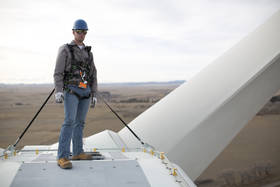As the world increasingly relies on wind power, more workers are required to help build and maintain turbines. Wind power companies can protect these workers and reduce fall risks by keeping in mind the following safety tips:
Develop, implement and communicate your work site’s fall protection plan. All work at height should be planned in advance, so workers can be instructed on the safest way to do their jobs. Safety managers should ensure workers are instructed on how to follow this plan before they begin work. Workers should then consistently follow the plan and use the appropriate protection equipment each and every day. As work processes and environments change, safety directors must be sure to keep these plans up-to-date and relevant. In case of emergencies, rescue plans should also be in place. Workers should be properly instructed on these rescue procedures as well.
Give workers the right equipment. Employers must be sure to provide workers with the right fall protection systems and equipment for their particular tasks and environments. When in doubt about whether a particular piece of equipment is right for the job, check the manufacturers’ instructions. Have safety managers conduct regular checks to ensure workers are using and wearing their gear appropriately – not too tight, or too loose.
Properly train workers. All workers-at-height should have the proper training and knowledge of work site safety, fall protection and rescue plans. Training and instructions should be communicated and made available in the appropriate languages for all workers. As new workers join the team, be sure each one is offered the same, comprehensive safety training as those on the original crew.
Ensure use of proper anchorages. Workers-at-height often select anchorage points that are inappropriate or unreliable. Even the best harness with the best lanyard or lifeline cannot arrest a fall with unsuitable anchorages. When selecting an anchorage point, workers should always ensure it is a safe distance above any lower obstacles, and in a direct line to the work station – to avoid any pendulum in the event of a fall.
Regularly inspect equipment. Using fall protection equipment that has passed its useful life is a potentially deadly mistake. Equipment must be inspected regularly and taken out of service if it shows wear and tear. If in doubt, throw it out.
While this fall protection tip list is not all inclusive, it provides a place to start for reducing fall risks.
By: Nora Schiess, Brand Manager, Honeywell Safety Products
Filed Under: News, Safety





